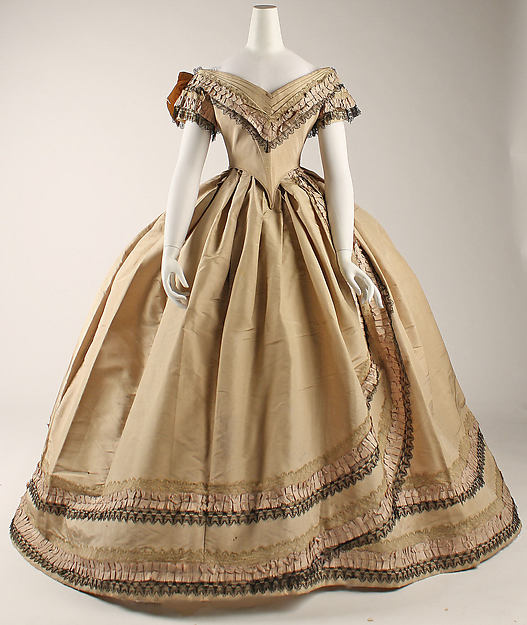Often, pictures circulate around Pinterest tagged with a vague date of "1860's" and they're hailed as beautiful creations of the Civil War era. They are all quite beautiful (I think 1865-1869 is probably my favorite half-decade in fashion history), but they should not and cannot be used as an inspiration piece to be worn to a sesquicentennial event, a ball, or any event that is focused on the years of the American Civil War. Because places like Pinterest and even some museum sites can often be vague, here are some hallmarks of gowns of the late 1860's:
1. Flat fronts
Both gowns shown here were dated "1860's" by their respective pinners on Pinterest. However, if you look at the skirt of the gown on the top, you can see that there is at least a ten inch panel of unpleated fabric in the front of the skirt. This is a hallmark of the late 1860's. This is the most noticeable of all of the trademarks of late 1860's fashions, as most dresses of that era possess this feature. The gown on the bottom is pleated all the way around, so it is more likely earlier.
2. Shaped skirt panels
On the dress on the top, it is easy to see that the front panel of the gown is shaped (looking at the seam down the front where the stripes go two different directions), and not a straight or "tube" skirt like the dress on the bottom. This is harder to see on original gowns, fashion plates, and portraits, but easier to notice in original sewing patterns. This kind of skirt is called a gored skirt, and usually has the regular amount of fullness in the back, but with a flatter shaped front panel.
3. On ball gowns--straight waists
As you can see on the top, this ball gown from the Kent State museum, dated 1860-1869, features a waistline just like you would see on any old day dress or evening dress. On the bottom, a gown from the Met Museum features a pointed waist. The pointed waist is one of the hallmarks of the early 1860's ball fashions. The straight waist for ball wear did not come into fashion until about 1864, and they did not gain in popularity until after the war.
4. Angular and/or unnatural placement of trim
The CDV on the top shows another trademark of the late 1860's, angular bodice trim and/or unnatural placement. Box-like bodice trim became very popular in 1864, along with other geometrical placements of bodice trim. This zig-zag is also interesting because it is placed in a random part of the bodice. During the early 1860's, as I have seen, most bodice trim follows the natural lines of the body and of the bodice itself. Therefore, a lot of trim along the bodice openings, the arms, and the darts (often continuing to the shoulders) is seen. The CDV on the bottom shows a woman that has regulated her bodice trim to the line where her yoke begins, which is more indicative of the early 1860's.
5. Skirt Peplums/"Butt fluff"
I have no idea what to call these things, so I'll let the pictures speak for themselves. These trends scream late 1860's and early 1870's, so it's very important to avoid them if you are making something to wear to early 1860's events.
Two examples of skirt "peplums", for lack of a better word.
And, two examples of "butt fluff". This includes, but is not limited to, bows, additional fabric, trim, etc.
Thank you everyone for listening! If you have any questions or additions, feel free to add them in the comments!









